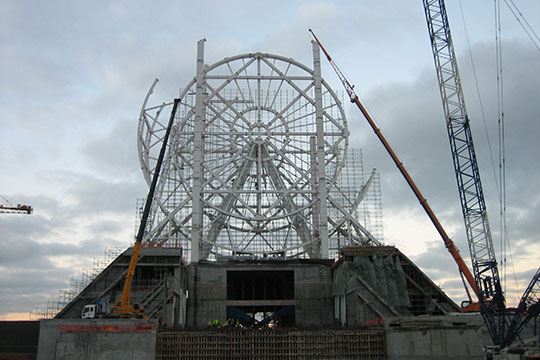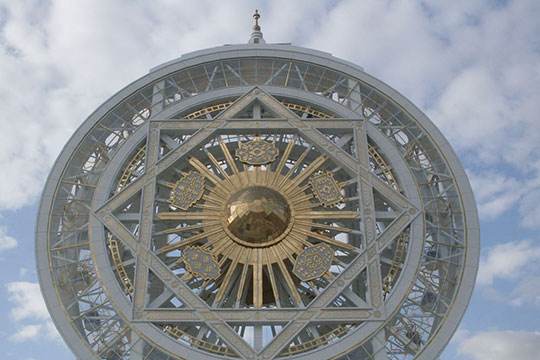Alem, which means “Universe”, has been awarded the Guinness World Record for the largest indoor Ferris wheel ever made. It is located in Ashgabat, the capital city of Turkmenistan, and hosted in a building dedicated to Magtymguly, a Turkmeni poet and spiritual leader.
The building where the Wheel is installed is a cultural centre, also used as entertainment centre featuring a bowling hall, a banqueting hall, a cinema, restaurants, etc. The Wheel is 75.3 meters high with a diameter of 47.6 meters and is located between two huge circular glass walls. In its 24 eight-seat closed cabins it hosts a total of 192 passengers.
The ride, inaugurated on a public holiday in May 2012, had a total cost of about 90 million USd. The total weight of the building, including the external decorative wall (Sun Rays), is about 12 thousand tons, the Wheel itself weighing about 150 tons. The structure is 95 m. high, the decorative outer wall being 17 m. high. The building has six floors, each 7 meters high, four of them above the ground floor, two below.
Category: Rides for Amusement Parks
Installation year: 2012
Height: 75.3 meters
Capacity: 192 passengers
Location: Ashgabat – Turkmenistan
Customer: Fabbri Group – Italy


Objectives
The main objective was to design a ride which, while making spectacular visual impact, was to be structurally compact, properly shaped and sized to fit into the hosting building and capable to meet the severe environmental requirements of the installation site. In order for this complex goal to be achieved, the maximum number of cabins and the Wheel’s overall structural frame were to be calibrated with painstaking precision.
to Be Met
The Wheel was to be designed to operate even in the absence of the building’s screening effect, which meant that the wind load was to be included among the environmental factors to be considered in calculation. In order to precisely estimate such load, experimental data were collected from aerodynamic wind tunnel test conducted on a 3D-printed 1:150-scaled model of the building.
Still more importantly, as the structure was to operate in a highly seismic area (its seismic spectrum having a PGA 0.84g and a Plateau of 2.1g), the fitting of the Wheel into the the building’s structural frame immediately appeared to pose a serious challenge. Any seismic action, as transferred to the elevated masses of a Wheel soaring 54.3 meters above ground, would produce inertial forces of considerable entity, which would accordingly require an oversizing of both the building’s columns and the foundation plinths. Through careful calibration of the structural profiles and masses, the resulting Wheel has proved flexible enough to buffer seismic stress on the structure in case of an earthquake.
The next challenge to be met was the verification of the interference between the Wheel and the building’s fine decorative walls as a consequence of antagonistic dynamic interaction between the two structures in case of a seismic event.
Implemented
As for the potential seismic effects along the structure’s vertical development, it would have been a mandatory choice, in theory, to uncouple the motion of the building’s main frame from that of the Wheel by means of viscous damping systems. This solution, however, would have been excessively expensive in production, installation and maintenance. It was therefore crucial to carefully investigate the potential behaviour of the whole structural system from the point of view of dynamic response prior to designing the Wheel in such a way as to reduce the transmission of seismic energy.
Achieved
At the end of the design and structural analysis stage, it was made apparent that the optimal solution we proposed for the Ferris wheel, by containing its total weight within the 150 ton limit, would fully meet the expected results in terms of dynamic response. The accurate assessment ad adjustment of the dynamics of the two coupled systems (i.e. the Wheel and building together) made any investment in expensive damping system redundant, with a considerable reduction in the total cost of the overall frame and foundations.


